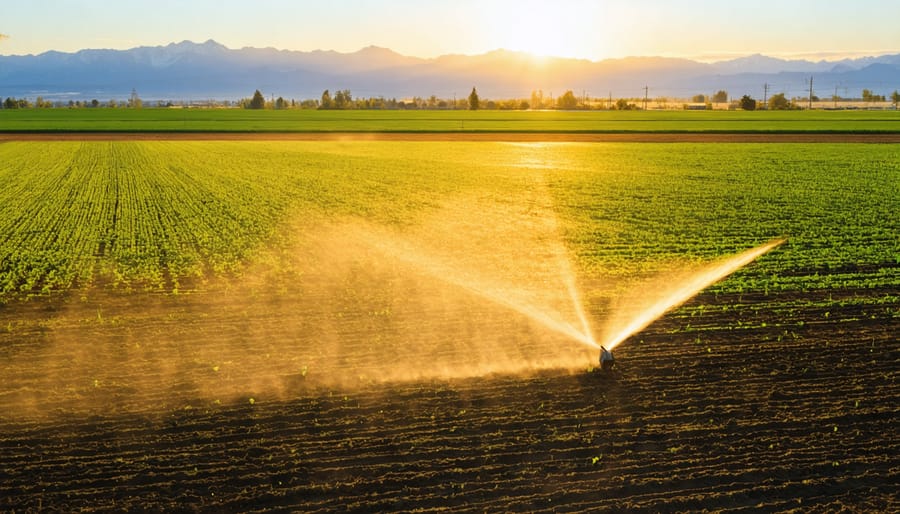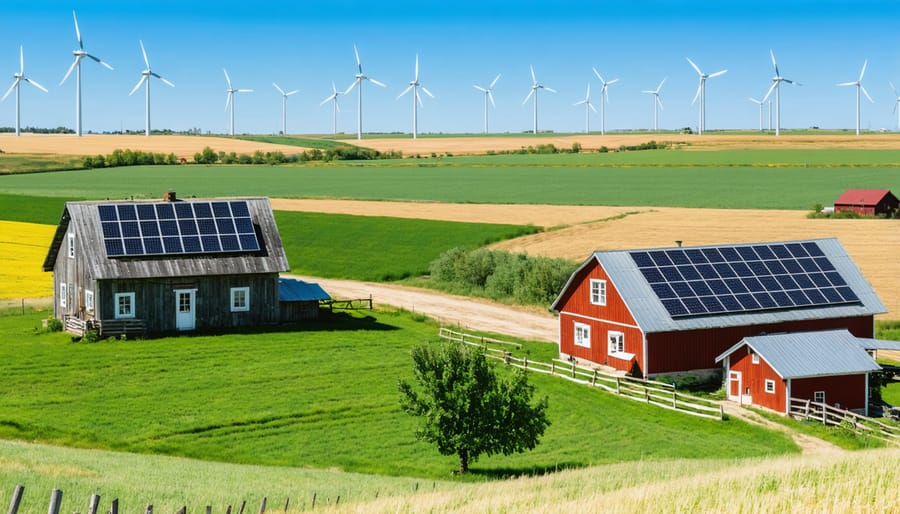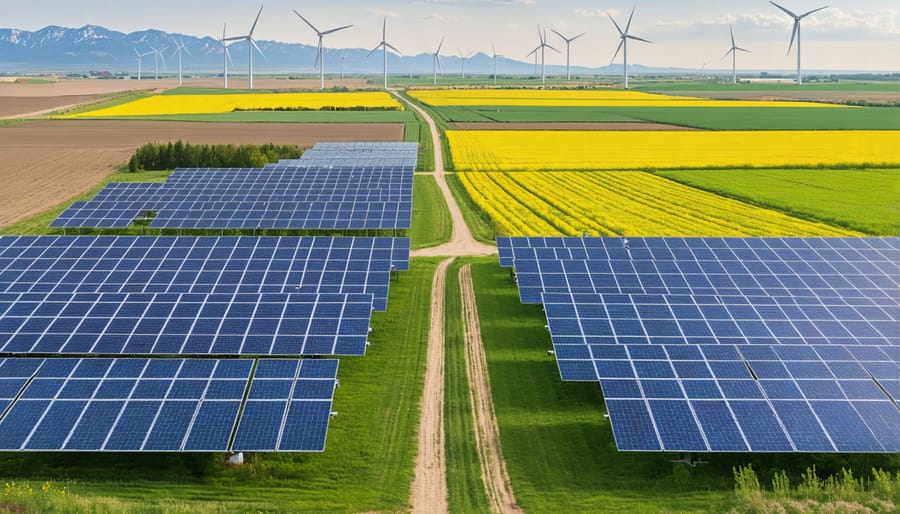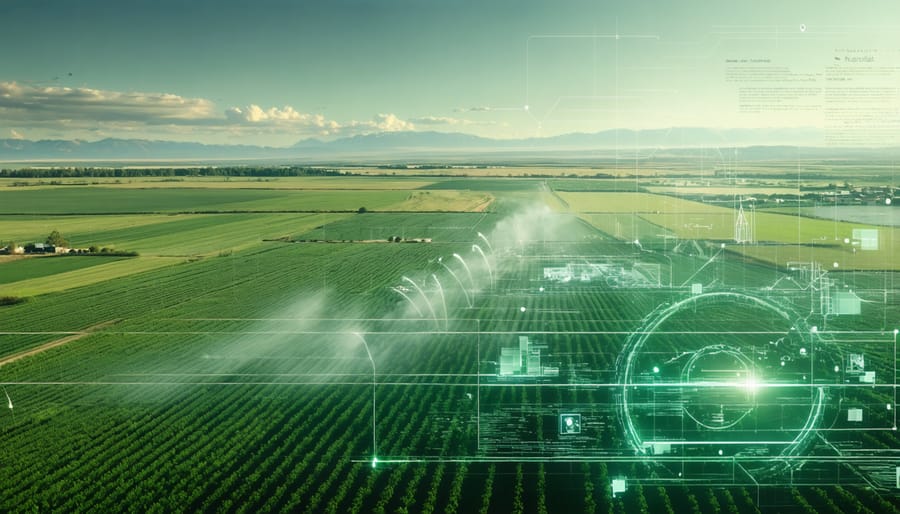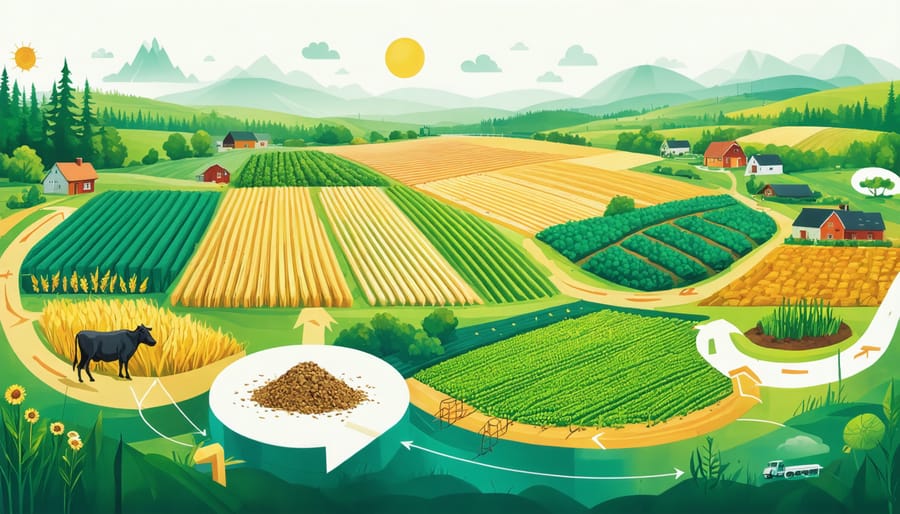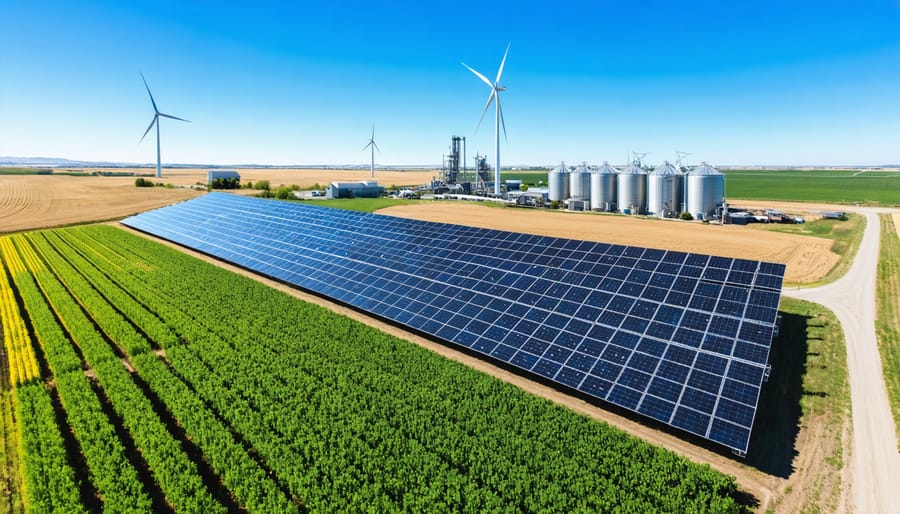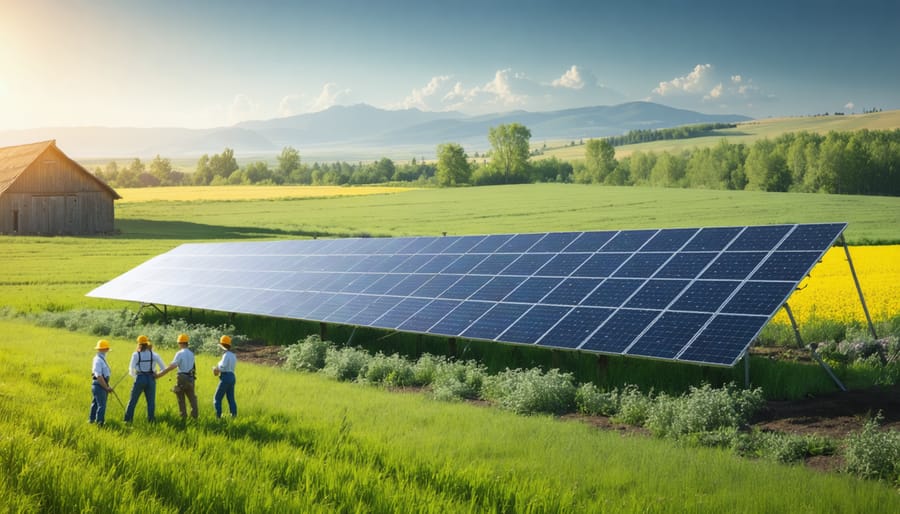Climate-smart agriculture revolutionizes traditional farming by merging productivity with environmental stewardship. Across Canada’s prairies, Alberta farmers tackling climate change have pioneered practices that simultaneously boost yields and build resilience against extreme weather patterns.
By implementing precision irrigation systems, practicing zero-till farming, and rotating diverse crop species, producers are reducing their carbon footprint while protecting their bottom line. These methods have proven particularly effective in Alberta’s variable climate, where unpredictable rainfall and temperature fluctuations challenge traditional farming approaches.
The shift toward climate-smart agriculture isn’t just about environmental protection—it’s about securing the future of farming itself. Data from Agriculture and Agri-Food Canada shows that farms using these practices typically reduce input costs by 15-30% while maintaining or improving crop yields. Through soil carbon sequestration, water conservation, and integrated pest management, producers are building agricultural systems that thrive in our changing climate while contributing to climate change mitigation.
This practical approach to sustainable agriculture represents a crucial evolution in farming practices, one that’s already delivering measurable benefits to both the environment and farm operations across the prairies.
Why Alberta Farmers Are Embracing Climate-Smart Agriculture
Local Climate Challenges
Alberta farmers face unique climate challenges that demand innovative agricultural solutions. Our prairie region experiences significant temperature fluctuations, with summer highs reaching 30°C and winter lows dropping below -30°C. These extreme variations, combined with unpredictable precipitation patterns, create complex growing conditions for local producers.
Recent years have seen an increase in severe weather events, including devastating hailstorms and prolonged drought periods. The 2021 drought, for instance, resulted in significant crop losses across the province, with some regions reporting yield reductions of up to 60%. Additionally, shifting frost dates and longer growing seasons are altering traditional planting and harvesting schedules.
Southern Alberta particularly struggles with water management issues, as irrigation demands increase during hot, dry spells. Meanwhile, central and northern regions often contend with excess moisture in spring, delaying seeding operations. The chinook winds, while providing welcome winter warming, can cause soil erosion and moisture loss when fields are vulnerable.
These challenges highlight the need for adaptive farming strategies that work with our unique climate conditions rather than against them.
Economic and Environmental Benefits
Implementing climate-smart agriculture practices offers significant economic advantages while protecting our environment. Alberta farmers who have adopted these methods report reduced input costs, with some seeing up to 30% savings on fuel and fertilizer expenses. By improving soil health through practices like reduced tillage and cover cropping, farmers can decrease their reliance on synthetic inputs while maintaining or even increasing yields.
The environmental benefits are equally compelling. These practices help sequester carbon in the soil, with estimates suggesting that Canadian agricultural lands could store an additional 10-20 megatonnes of CO2 annually. Better water management techniques reduce runoff and erosion, protecting our precious water resources while improving drought resilience. Many farmers also report increased biodiversity on their lands, including beneficial insects and wildlife.
From a business perspective, climate-smart practices can open new market opportunities. Consumer demand for sustainably produced food continues to grow, and many Alberta farmers are now accessing premium markets. Additionally, these practices can help qualify farms for environmental incentives and carbon credit programs, creating new revenue streams while contributing to climate change mitigation.
Proven Climate-Smart Techniques for Alberta Farms
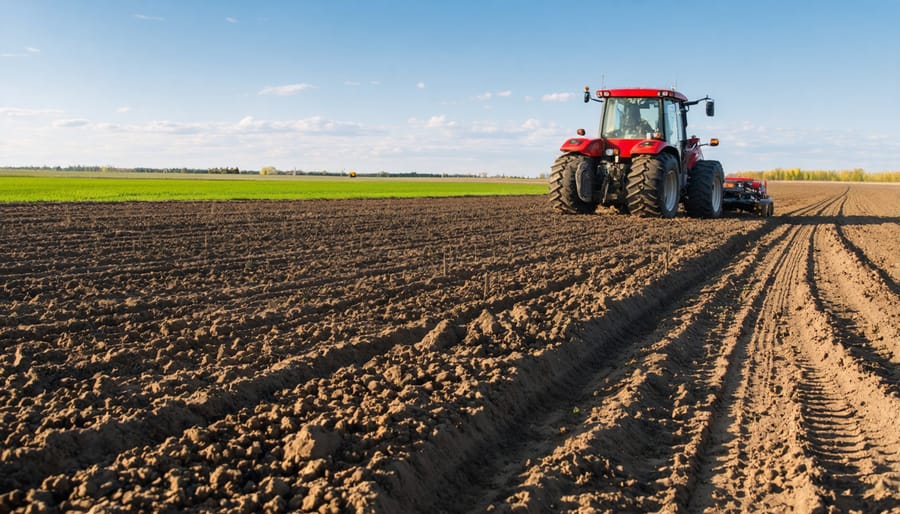
Soil Health Management
Healthy soil is the foundation of climate-smart agriculture, acting as both a productive growing medium and a powerful carbon sink. Alberta farmers are increasingly adopting innovative soil health management techniques that boost resilience while capturing atmospheric carbon.
Key practices include maintaining year-round soil cover through cover cropping and residue management. Winter cereals like fall rye and perennial forages protect soil from erosion while building organic matter. Minimizing soil disturbance through reduced tillage or no-till methods helps preserve soil structure and beneficial microorganisms.
Crop rotation diversity is another crucial element, with local farmers incorporating pulse crops like field peas and lentils to naturally fix nitrogen. Adding livestock to the rotation through adaptive grazing helps cycle nutrients and stimulate root growth.
Regular soil testing guides informed decisions about amendments and helps track progress. Many Alberta producers are seeing success with biological amendments like compost tea and beneficial microorganisms to enhance soil life.
These practices work together to increase water retention, improve nutrient cycling, and build soil organic carbon levels. Local farmers report needing less fertilizer input while maintaining yields, creating both environmental and economic benefits. Starting with small field trials allows producers to adapt these methods to their specific conditions while building confidence in the approach.
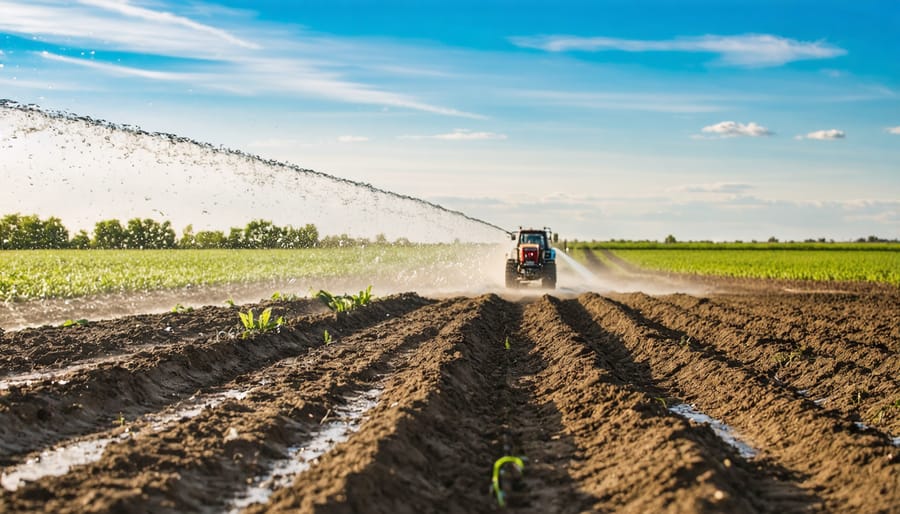
Water Conservation Strategies
In Alberta’s increasingly variable climate, implementing effective water conservation strategies is crucial for farm sustainability. Modern irrigation techniques like drip systems and precision sprinklers can reduce water usage by up to 30% compared to traditional flood irrigation methods.
Many Alberta farmers are adopting soil moisture sensors and weather monitoring systems to optimize irrigation scheduling. These tools help determine exactly when and how much water crops need, preventing both under and over-watering. For instance, the Brown family farm near Lethbridge saved 2.5 million litres of water in one growing season by implementing sensor-based irrigation management.
Mulching and cover cropping are proving particularly effective in our climate, helping soil retain moisture while improving its structure. Conservation tillage practices can reduce evaporation by leaving crop residue on the field, maintaining soil moisture levels throughout the growing season.
Water storage solutions, such as dugouts and retention ponds, are becoming increasingly important. These systems capture snowmelt and rainfall for use during dry periods. Some innovative farmers are also implementing grey water recycling systems for non-food crops, maximizing water efficiency across their operations.
Remember, even small changes like maintaining irrigation equipment and fixing leaks can lead to significant water savings over time. Consider conducting regular water audits to identify areas for improvement in your irrigation system.
Crop Diversification
Growing multiple crop varieties and implementing strategic rotation cycles offers Alberta farmers significant resilience against climate-related challenges. Research has shown numerous crop diversification benefits, including improved soil health, reduced pest pressure, and enhanced income stability.
Consider rotating between cereals, pulses, and oilseeds to maximize soil nutrient cycling. For example, following canola with wheat, then field peas creates a balanced three-year rotation that reduces disease risk while improving nitrogen fixation. Many Alberta farmers have successfully integrated cover crops like clover or rye between main growing seasons, protecting soil from erosion and adding organic matter.
Local success stories demonstrate the practical advantages of diversification. The Peterson family farm near Lethbridge increased their profit margins by 15% after introducing chickpeas and lentils into their traditional wheat rotation. Similarly, farms in the Peace River region have found that alternating between canola and fava beans helps break disease cycles while providing additional market opportunities.
Start small by introducing one new crop variety on a portion of your land. Work with local agronomists to identify suitable crops for your soil type and climate conditions. Remember to consider market access and storage requirements when selecting new crops. Many agricultural communities have established equipment-sharing programs to help offset the initial costs of diversification.
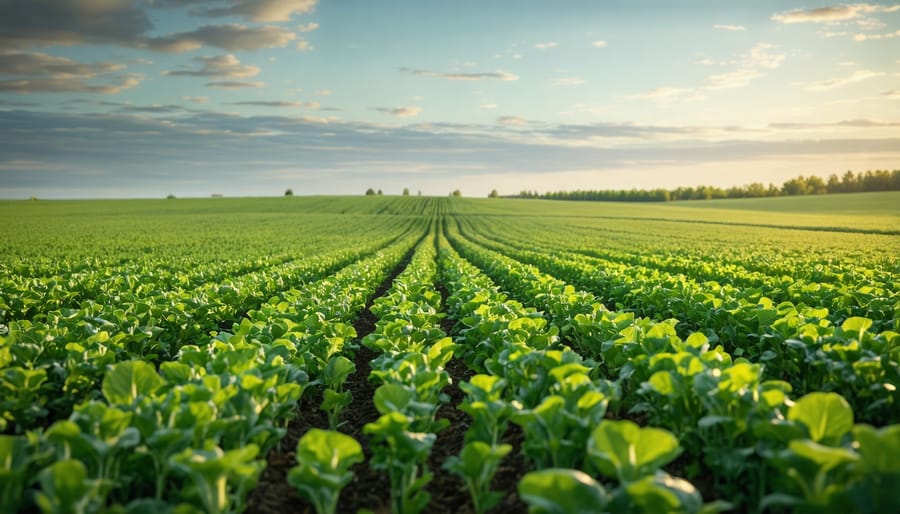
Energy-Efficient Farm Operations
Reducing energy consumption on your farm not only cuts operational costs but also significantly decreases your carbon footprint. Here in Alberta, many farmers are discovering innovative ways to make their operations more energy-efficient while maintaining productivity.
Start by conducting an energy audit of your farm operations. This helps identify areas where you’re using the most energy and opportunities for improvement. Common high-consumption areas include irrigation systems, grain drying, and dairy operations.
Consider upgrading to energy-efficient equipment and implementing smart technologies. LED lighting in barns and storage facilities can reduce electricity usage by up to 75% compared to traditional lighting. Variable frequency drives (VFDs) on irrigation pumps and ventilation systems can optimize energy use based on actual demand.
Many Alberta farmers are now incorporating solar panels to offset electricity costs. The province’s abundant sunshine makes solar energy a viable option, with some operations generating enough power to sell back to the grid. Regular maintenance of equipment, including tractors and implements, ensures optimal fuel efficiency and reduces unnecessary energy waste.
Simple changes like installing proper insulation in farm buildings and using programmable thermostats can lead to substantial energy savings. The Environmental Farm Plan program offers guidance and potential funding for energy-efficiency improvements.
Remember to track your energy usage and savings – this data helps demonstrate the return on investment and identifies areas for further improvement.
Success Stories: Alberta Farmers Leading the Way
Case Study: The Thompson Family Farm
Located just outside of Lacombe, Alberta, the Thompson Family Farm has become a shining example of successful climate-smart agriculture implementation. Third-generation farmer Sarah Thompson and her family transformed their 800-hectare operation over the past five years, incorporating multiple innovative practices that have both reduced their environmental impact and improved their bottom line.
The Thompsons began by implementing a comprehensive soil management strategy, including zero-till practices and cover cropping. They planted a diverse rotation of crops, including wheat, canola, and pulse crops, while maintaining living roots in the soil year-round. This approach has increased their soil organic matter by 2% and significantly reduced erosion.
Their most notable innovation was the installation of a precision irrigation system, which cut their water usage by 40% while maintaining crop yields. The family also integrated solar panels on their barn roof, providing 60% of their farm’s electricity needs.
“The changes weren’t always easy,” Sarah admits, “but the results have been worth it. We’re seeing better soil health, reduced input costs, and more consistent yields, even in challenging weather years.” The farm has documented a 30% reduction in fertilizer use through precision agriculture techniques and has decreased their fuel consumption by implementing GPS-guided equipment.
The Thompsons now regularly host field days for local farmers, sharing their experiences and encouraging others to adopt climate-smart practices.
Case Study: Prairie View Acres
Located just outside of Red Deer, Alberta, Prairie View Acres has become a shining example of successful climate-smart agriculture implementation. Farm owners Mark and Sarah Thompson transformed their 800-hectare operation from conventional farming methods to a water-conscious, soil-first approach over the past five years.
The Thompsons installed a precision irrigation system that reduced their water usage by 40% while maintaining crop yields. They implemented soil moisture sensors across their fields, allowing them to make data-driven decisions about irrigation timing and quantity. This technology helped them save approximately 50 million litres of water annually.
Their soil management strategy includes year-round cover crops and minimal tillage practices. By incorporating crops like fall rye and field peas into their rotation, they’ve increased organic matter in their soil by 2% and significantly improved water retention capacity. This approach has proved particularly valuable during dry spells, with their fields showing remarkable resilience compared to neighbouring farms.
The financial investment in these changes was recovered within three years through reduced input costs and improved yields. The Thompsons now host regular field days, sharing their experiences with other Alberta farmers. Their success has inspired a growing network of local producers to adopt similar practices, creating a ripple effect of sustainable agriculture in the region.
Getting Started with Climate-Smart Agriculture
Starting your journey with climate-smart agriculture doesn’t have to be overwhelming. The key is to begin with small, manageable steps while developing a long-term plan for your farm. First, assess your current practices and identify areas where you can make immediate improvements in soil health, water management, or energy efficiency.
Connect with your local agricultural extension office or the Alberta Agriculture and Forestry department for guidance. They offer free soil testing services and can help you understand your land’s specific needs. Many experienced farmers in our region have already adopted climate-smart practices and are often willing to share their knowledge through mentorship programs.
Consider joining a local agricultural organization or attending workshops focused on sustainable farming. The Environmental Farm Plan (EFP) program provides excellent resources and potential funding opportunities for implementing climate-smart practices. Start with one or two practices that align with your farm’s goals, such as reduced tillage or cover cropping, and gradually expand your approach.
Document your progress by keeping detailed records of changes in soil quality, water usage, and crop yields. This data will help you track improvements and make informed decisions about future adaptations. Remember, successful climate-smart agriculture is about continuous learning and adaptation – you don’t need to transform your entire operation overnight.
Free resources are available through Alberta’s Climate Information Service to help you understand weather patterns and make climate-informed decisions for your farm.
Climate-smart agriculture represents a vital pathway forward for Canadian farmers, offering practical solutions that benefit both our agricultural productivity and environmental stewardship. By implementing these sustainable practices, Alberta’s farming community is already demonstrating leadership in addressing climate challenges while maintaining robust crop yields and soil health. The success stories from local farms prove that these methods are not just theoretical but achievable and profitable.
As we face increasing climate uncertainties, the time to act is now. Whether starting with simple changes like cover cropping or advancing to precision agriculture technologies, every step matters. Remember, you’re not alone in this journey – our agricultural extension services, local farming associations, and fellow producers are here to support your transition to climate-smart practices. Together, we can build a more resilient and sustainable agricultural future for Alberta and generations to come.

